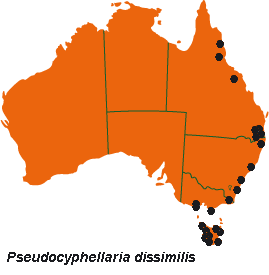



Australian Biological Resources Study
| Checklist of the Lichens of Australia and its Island Territories | ||
| Introduction | A–D | E–O | P–R | S–Z | Oceanic Islands | References | ||
| Pseudocyphellaria dissimilis (Nyl.) D.J.Galloway & P.James | ||
| Lichenologist 12: 297 (1980); Stictina fragillima var. dissimilis Nyl., Syn. Meth. Lich. 1(2): 336 (1860); Sticta fragillima var. dissimilis (Nyl.) Kremp., in E.Fenzl, Reise Novara 2: 119 (1870); Cyanisticta dissimilis (Nyl.) Räsänen, J. Jap. Bot. 16: 143 (1940). T: Australia, s. loc., E.Hampe; lecto: H-NYL 34103, fide D.J.Galloway & P.W.James, Lichenologist 12: 297 (1980). Stictina fragillima var. dissecta Müll.Arg., Flora 66: 22 (1883); Sticta fragillima var. dissecta (Müll.Arg.) Hellb., Bih. Kongl. Svenska Vetensk.-Akad. Handl. 21(3/13): 32 (1896). T: Norfolk Island, Dr Wools; lecto: G, fide D.J.Galloway, Bull. Brit. Mus. (Nat. Hist.), Bot. 17: 123 (1988); syn: G. | ||
| Thallus very variable, irregularly spreading, loosely to closely attached centrally, 5–12 (–15) cm wide; margins ±free. Lobes linear-elongate to shallowly rounded, (1–) 2–5 (–8) cm long, (1–) 3–8 (–10) mm wide, subdichotomously to irregularly branching, ±discrete at apices, complex-imbricate centrally, often canaliculate and divided into numerous phyllidia; lobe margins entire, sinuous, ridged above, thickened below, isidiate-phyllidiate. Upper surface pale grey-blue to glaucous brownish when dry, dark grey-blue to blue-black when wet, smooth to shallowly wrinkled, maculate. Maculae white, minute, laminal, scattered, irregular, pale buff or brown photobiont-free areas often present as ±extensive patches. Isidia marginal and laminal, simple, terete, to 3 mm tall and 0.1 mm diam., becoming densely crowded-coralloid and eventually flattened-phyllidiate. Medulla white. Photobiont Nostoc. Lower surface white or pale buff, glabrous at margins, costate and brownish-tomentose centrally. Pseudocyphellae white, punctate. Apothecia sessile, marginal and laminal; disc yellow-brown to red-brown, epruinose; exciple scabrid-areolate; epithecium yellow-brown to pale red-brown, K–; hymenium colourless; hypothecium yellow-brown to pale straw-yellow, K–. Ascospores fusiform-ellipsoidal, 1–3-septate, 20.5–29.5 × 7–9 µm, pale yellow-brown. CHEMISTRY: 7β-acetoxyhopane-22-ol, hopane-7β,22-diol (trace), hopane-15α,22-diol, gyrophoric acid and methyl gyrophorate. |  |
|
| Occurs in eastern Qld, eastern N.S.W., southern Vic. and Tas.; common in wet-sclerophyll forest and callidendrous rainforest in Tas. where it occurs on rocks, soil, peat, logs, tree buttresses and tree fern trunks. Also in Norfolk Is., New Zealand and the Palaeotropics. | ||
| Galloway et al. (2001) | ||
| Checklist Index |
| Introduction | A–D | E–O | P–R | S–Z | Oceanic Islands | References |
This work is copyright. Apart from any use as permitted under the Copyright Act 1968, no part may be reproduced by any process without prior written permission from Australian Biological Resources Study. Requests and inquiries concerning reproduction and rights should be addressed in the first instance to Dr P. McCarthy. These pages may not be displayed on, or downloaded to, any other server without the express permission of ABRS.